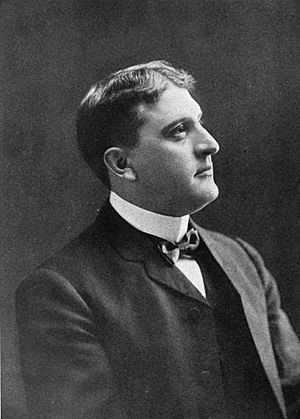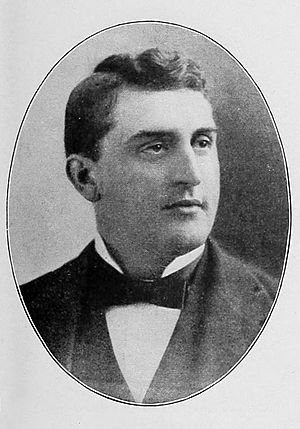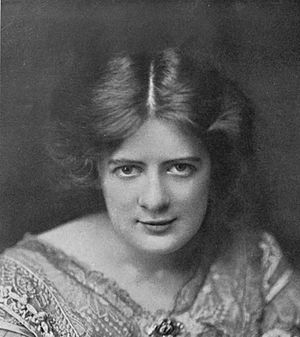F. Augustus Heinze facts for kids
Frederick "Fritz" Augustus Heinze (December 5, 1869 – November 4, 1914) was an American businessman. He was known as one of the three "Copper Kings" of Butte, Montana. The other two were William Andrews Clark and Marcus Daly. Heinze was a very smart and charming person. Many people in Montana saw him as a hero.
Contents
Early Life and Education
Fritz Augustus Heinze was born in Brooklyn, New York. His parents, Otto Heinze from Germany and Elizabeth "Lida" Lacey from Ireland, were wealthy immigrants. He was called Fritz but often went by F. Augustus. Later, he used the name Frederick.
He was very bright and received a good education. From age 9 to 15, he studied in Germany. He also attended Brooklyn Polytechnic Institute, which is now part of NYU. He could speak several languages fluently. In 1889, he graduated from Columbia School of Mines in New York. His father wanted him to study more in Germany. However, Heinze decided to go west to Colorado and Salt Lake City. He wanted to follow his interest in mining.
Mining in Montana
Heinze arrived in Butte, Montana, in 1889. He worked as a mining engineer for the Boston and Montana Company. He was known for being fun-loving and social in Butte's saloons. He also had good manners and dressed well.
Heinze received $50,000 from his father's inheritance. This helped him become a major player in the mining business. In 1894, his Montana Ore Purchasing Company opened a new smelter. A smelter is a place where metal is taken out of ore. This allowed Heinze to offer low-cost smelting to smaller mining companies.
At first, Heinze had to lease mines and buy ore from other companies. He was good at finding rich ore deposits. In 1895, he bought the Rarus Mine. This mine became one of Butte's best mining properties.
Heinze came to Butte after the other "Copper Kings," William A. Clark and Marcus Daly, were already famous. Daly's company was Anaconda Copper. Later, it was called Amalgamated Copper Mining Company. Its directors, William Rockefeller and Henry H. Rogers, were also important figures at Standard Oil.
To catch up, Heinze used smart strategies. He reduced the workday for his miners from ten to eight hours. Because of this, his miners saw him as a hero. The General Mining Act of 1872 had a rule called the "law of the apex." This rule allowed a mine owner to dig for ore veins that started on their land. They could follow these veins even if they went under land owned by others. Heinze used this law to claim the right to take copper ore from under his neighbors' properties. He hired many lawyers, sometimes up to 30 at once. He used the legal system to challenge his opponents in court again and again.
Heinze also used his political skills. He made sure that judges who were "friendly" to him were appointed in Montana. He became a great public speaker. In his speeches, he told miners and the public that the Amalgamated Company was unfair and powerful.
In 1902, Heinze combined his mining interests into a company called United Copper Company. This company was valued at $80 million. It could produce 40 million pounds of copper each year. Amalgamated produced 143 million pounds a year.
In 1903, a court ordered Heinze to stop mining at his Rarus property. However, his miners still went into an Amalgamated property next door. Before they were stopped, Heinze managed to take out a lot of valuable copper ore. There were fierce battles underground between Heinze's and Amalgamated's miners. Dynamite was even used, which destroyed parts of the mine. Heinze was charged with breaking the court order. He was fined $20,000.
Heinze's actions caused big problems for the Amalgamated Company. In 1906, after ten years of mining disputes, John D Ryan made a deal with Heinze. Heinze agreed to sell his mining interests in Butte to Amalgamated for $12 million. This ended his mining days in Butte, Montana. Heinze had become very rich.
Role in the Panic of 1907
In 1907, Heinze moved to New York City. He wanted to become a major player in the financial world. He set up his company, United Copper, near Wall Street. Heinze also got into banking. He worked closely with Charles W. Morse. They served on the boards of many banks and financial companies together.
Heinze's brothers, Otto and Arthur P Heinze, had a stock brokerage firm nearby. Otto came up with a risky financial plan in October 1907. This plan failed badly and helped cause a huge American financial crisis. It was called the "Panic of 1907".
Otto's plan was to buy a lot of United Copper stock. This would make the price go up very high. Then, Otto would control most of the stock. He would force people who had borrowed the stock (called "short-sellers") to buy it back. These short-sellers would have to pay Otto very high prices.
But Otto misjudged how much stock his family controlled. When he tried to force the short-sellers to buy back the stock, they found it from other sources. When the market realized his plan had failed, the price of United Copper stock crashed.
Panic spread from there. People started taking their money out of banks connected to Heinze. Then they pulled money from other financial companies linked to those banks. Heinze had supported his brother's plan. Because he was so involved in the financial system, he lost a lot of money and faced personal difficulties. He was not allowed to be involved in financial institutions anymore.
The Panic of 1907 was one of the biggest financial crises in American history. Other things contributed to it, like the high cost of the 1906 San Francisco earthquake. However, the actions of the Heinze brothers caused much of the panic. This crash eventually led to the creation of the US Federal Reserve System in 1913.
Legal Challenges
In 1908, Heinze faced legal challenges for his role in the stock market events. There were many court cases in New York that lasted for years. However, he was cleared of the charges.
When Heinze returned to Butte after being cleared, it was a huge event. People met his train with bands and a parade of cars. Many people helped pull a wagon with a rope, showing their support for their hero.
One interesting story was about missing financial records for United Copper. In June 1909, Heinze and others were accused of hiding the company's books and letters. People followed them as they moved trunks full of company records. The trunks traveled from New York to New Jersey and back. One man tried to take a heavy trunk to Montreal, Quebec, Canada, but the railway worker would not accept it. The trunks were eventually found in a basement in New York. Two more trunks were missing, but Heinze promised a judge he would find them.
After the books were hidden, the directors of the United Copper Company tried to remove Heinze. But the day before they could do it, he replaced the board of directors. This stopped them from removing him.
Mining in Utah
Before the events of 1907, Heinze became interested in mines in Bingham Canyon, Utah. This area is southwest of Salt Lake City. Heinze bought a major share in the Bingham Consolidated Mining and Smelting Company and the Ohio Copper Company. While Heinze was dealing with his legal challenges, these mining operations struggled to get money. Heinze's involvement in Utah ended up causing more problems than help.
The mining operations and mills in Bingham Canyon were in a very narrow canyon. People joked that a dog had to wag its tail up and down, not side to side, because the canyon was so narrow.
The Mascotte Tunnel
The Ohio Copper Company wanted to have an advantage over its rivals. They planned to build a large mill outside the canyon. To get the ore from the mines to this new mill, they needed a tunnel. Work on expanding an existing tunnel, called the Dalton & Lark tunnel, began in 1907. This three-mile-long tunnel was named the Mascotte Tunnel.
The Mascotte tunnel was owned by Bingham Consolidated, a company that was facing financial trouble. Heinze saw an opportunity. Bingham Consolidated (with Heinze as a major owner) sold the unfinished tunnel to the Bingham Central Railway Company. This company was fully owned by Heinze. He bought the tunnel for $150,000. With this deal, Heinze owned the only way to connect the Ohio Copper Company's mines to its mill.
When the tunnel was finished in March 1909, the General Manager, Colin McIntosh, praised the work. He said it was one of the most difficult surveying jobs in the state. Heinze visited Salt Lake City for the first time since 1906 to see the facilities. Miners, many of whom had worked for Heinze in Montana, greeted him with great joy.
In 1909, shareholders of the Ohio Copper Company were worried about Heinze's control. He owned the Mascotte tunnel, which was the company's only way to transport ore. People were concerned that Heinze might prevent the company from using the tunnel.
John D Ryan (who had made the deal with Heinze in Montana) and Thomas F Cole from Amalgamated Copper offered to buy the Ohio Copper Company from Heinze. But they wanted the Mascotte tunnel to be part of the deal. Heinze refused to sell the tunnel.
By December 1910, there was growing concern about how the Ohio Copper Company was being run. Large shareholders were unhappy with Heinze's management. They felt the company was not earning enough money to pay its debts. The Bingham Central Railway Company was charging the Ohio Copper Company 15 cents for each ton of ore transported through the Mascotte tunnel. This earned Heinze about $200–300 per day.
Heinze's Departure
In February 1913, the United Copper Company faced financial difficulties. Its assets, including Ohio Copper, were put under special management. In mid-1914, at a meeting with many arguments, control of the Ohio Copper Company passed from Heinze to William O Allison. Allison was the company's president. Payments that were due had not been made. Heinze claimed this was because of his ongoing legal costs.
After Heinze left, the Bingham Central Railway Company (which owned the Mascotte tunnel) became part of the new Ohio Copper Company. The combined company was named the Ohio Copper Mining Company of Utah. It operated until 1951. Today, the properties of Ohio Copper are part of the huge Bingham Canyon Mine.
Family and Death
On August 31, 1910, Heinze married the actress Bernice Golden Henderson. Their son, F. Augustus Heinze Jr., was born on December 6, 1911. They divorced in 1912. However, they became friends again before Bernice died in 1913.
In November 1914, Heinze became very ill and died at 44 years old. Heinze did not leave a will. Two women claimed to be legally married to him and fought over his estate. But his money was left to his two-year-old son, Fritz Augustus Jr. His son was adopted by Heinze's sister, Mrs. Lida Fleitmann.
The Philadelphia Inquirer newspaper wrote that Heinze's efforts might have helped Montana. However, his early death showed the risks of being a speculator. Some people in Butte, Montana, thought about building a statue to honor him, but it never happened.
Images for kids
See also
 In Spanish: F. Augustus Heinze para niños
In Spanish: F. Augustus Heinze para niños







